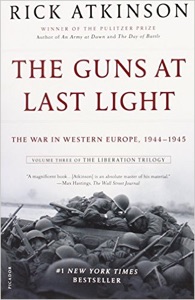The Guns At Last Light
The concluding volume of Rick Atkinson’s biography of the US Army in the Second World War shares many of the strengths of its predecessors: generosity, vision, and expanse. This volume covers the campaign from Normandy to Berlin, a story now so familiar and so heavily fictionalized that some historical episodes, such as Patton’s ill-fated and ill-advised effort to rescue his captured son-in-law, Lt. Col. John Knight Waters, are confusing to read because we know the fiction so well.
What made the first book, An Army At Dawn, so compelling was that it saw the flaws and errors of the new American army so clearly, and described them so well. There’s less of that here, in part because it’s hard to see problems in the glare of victory. When an army is losing narrowly, the blunders and missed opportunities are clear. When it’s winning, no one notices lapses in training and attention.
One thing that’s getting hard to appreciate is the scale of logistics in WW2, all managed without calculators or computers. The Army was running a supply operation with 800,000 SKUs, all shipped overseas at enormous expense, and any of which might be urgently needed almost anywhere. Sorting this out would have been hard enough if there hadn’t been a war on; the story of this success is less fun than it might have been because the leadership of the supply operation was unpleasant and a good deal of the day-to-day operations were, perhaps inevitably, corrupt.
